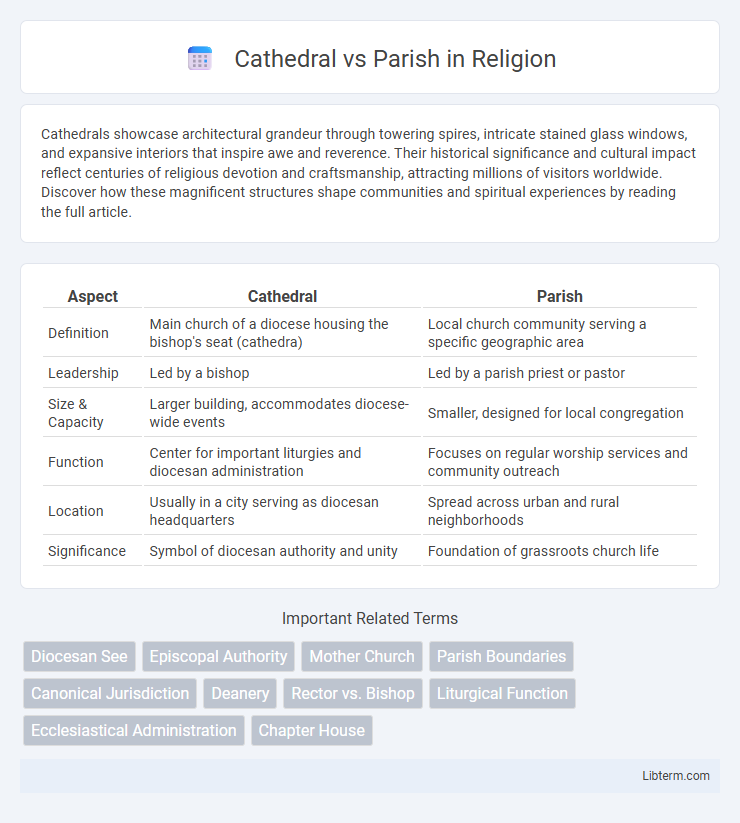Cathedrals showcase architectural grandeur through towering spires, intricate stained glass windows, and expansive interiors that inspire awe and reverence. Their historical significance and cultural impact reflect centuries of religious devotion and craftsmanship, attracting millions of visitors worldwide. Discover how these magnificent structures shape communities and spiritual experiences by reading the full article.
Table of Comparison
| Aspect | Cathedral | Parish |
|---|---|---|
| Definition | Main church of a diocese housing the bishop's seat (cathedra) | Local church community serving a specific geographic area |
| Leadership | Led by a bishop | Led by a parish priest or pastor |
| Size & Capacity | Larger building, accommodates diocese-wide events | Smaller, designed for local congregation |
| Function | Center for important liturgies and diocesan administration | Focuses on regular worship services and community outreach |
| Location | Usually in a city serving as diocesan headquarters | Spread across urban and rural neighborhoods |
| Significance | Symbol of diocesan authority and unity | Foundation of grassroots church life |
Understanding Cathedrals and Parishes
Cathedrals serve as the central church of a diocese, typically housing the bishop's official seat, or cathedra, symbolizing ecclesiastical authority and governance. Parishes represent local church communities led by parish priests, functioning as the primary point of worship and pastoral care for residents within specific geographic boundaries. Understanding the distinction between cathedrals and parishes is essential for recognizing the hierarchical structure and organizational roles within many Christian denominations.
Historical Origins of Cathedrals and Parishes
Cathedrals originated in medieval Europe as principal churches housing the bishop's seat, symbolizing ecclesiastical authority and often serving as administrative centers for dioceses. Parishes developed earlier as local communities led by parish priests, providing direct pastoral care and spiritual services to residents of a specific geographic area. The distinct historical roles of cathedrals and parishes reflect evolving church structures, with cathedrals emphasizing hierarchy and governance, while parishes focus on community-level ministry.
Key Differences Between Cathedrals and Parishes
Cathedrals serve as the central church of a diocese, housing the bishop's official seat, known as the cathedra, symbolizing his ecclesiastical authority. Parishes are local church communities led by parish priests, catering to the spiritual needs of their specific neighborhoods or towns. While cathedrals often feature grand architectural designs and host major diocesan events, parishes focus on regular worship services, community outreach, and pastoral care at a more localized level.
Roles and Functions in Christian Communities
A cathedral serves as the principal church and administrative center of a diocese, housing the bishop's official seat known as the cathedra, which symbolizes ecclesiastical authority and governance. Parishes function as local communities within the diocese, providing regular worship services, pastoral care, and sacraments to congregants, and are typically led by parish priests or pastors. While cathedrals emphasize liturgical leadership and diocesan coordination, parishes focus on fostering daily spiritual life and community engagement among believers.
Architectural Distinctions: Cathedral vs Parish Church
Cathedrals are architecturally grander, often featuring intricate Gothic or Romanesque designs with soaring spires, large stained-glass windows, and expansive naves that symbolize their status as the bishop's seat. Parish churches typically have simpler, more modest structures designed to serve local congregations, with functional layouts and fewer ornamental details. The architectural distinction is also marked by the presence of a cathedra, or bishop's throne, in cathedrals, which is absent in parish churches.
Leadership: Bishops, Priests, and Their Responsibilities
Cathedrals serve as the principal church of a diocese and are led by bishops who hold the highest ecclesiastical authority, overseeing multiple parishes within their jurisdiction. Priests manage parish churches, providing daily pastoral care, conducting sacraments, and fostering community within their local congregation. The bishop's leadership includes administrative duties, spiritual guidance, and representing the church in broader religious and civic contexts, while priests focus on direct interaction with parishioners and local church activities.
Liturgical Practices and Services
Cathedrals typically host more elaborate liturgical practices and services, including solemn Masses, special ceremonies, and diocesan events led by bishops. In contrast, parish churches focus on regular Sunday Mass, sacraments like baptisms and weddings, and community-based worship. Cathedrals emphasize ceremonial grandeur and liturgical diversity, while parishes prioritize pastoral care and local congregation participation.
Community Impact and Outreach
Cathedrals often serve as central hubs for diocesan events, offering extensive community outreach programs that address social issues like poverty, education, and healthcare, thereby impacting a broader population. Parishes focus on localized engagement, fostering close-knit community relationships through regular worship services, youth activities, and neighborhood support initiatives. Both play vital roles in spiritual growth and social cohesion, with cathedrals acting as regional landmarks of faith and parishes nurturing daily community life.
Notable Cathedrals and Parish Churches Worldwide
Notable cathedrals like St. Peter's Basilica in Vatican City, Notre-Dame de Paris in France, and Westminster Cathedral in London are distinguished by their role as the bishop's seat and architectural grandeur. Parish churches such as St. Mary's in Minneapolis, USA, and St. Martin-in-the-Fields in London serve local communities primarily for regular worship and often showcase regional architectural styles. These landmarks reflect the religious, cultural, and historical significance of cathedrals and parish churches across the globe.
Choosing Between Cathedral and Parish for Worship
Choosing between a cathedral and a parish for worship depends on the size, location, and community focus of the congregation. Cathedrals, often located in urban centers, serve as the central church of a diocese and offer elaborate liturgies, historic architecture, and larger congregational events. Parishes provide a more intimate, community-centered worship experience tailored to local needs and regular spiritual support.
Cathedral Infographic

 libterm.com
libterm.com